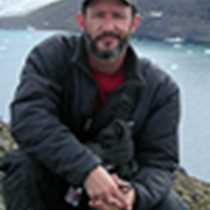GO BEARS!
The Stanford alumni have been enjoying the wonderful sights, sounds, tastes, feelings, and scents of Southeast Alaska for the past week. To see and hear the great humpback and killer whales as they moved smoothly past the ship reminded us of our landlocked nature. The sweet taste of berries along the trails filled our stomachs, not to mention the satisfying food served aboard the ship. The feeling of sun shining down on our faces the first half of the trip made wet cool Alaska seem like mythology. The scent of a clean forest or intertidal zone awakened in us the recognition of a place untouched or at least hardly touched at all by earlier visitors.
All of this sensory input has trained us for the last day. Our visit to Glacier Bay National Park has been anticipated by all aboard. This is a young park (1980) in a young bay (full of ice in 1794). The look is of a place still struggling with growing pains. Parts of the park actually grow upwards a couple of inches per year. The plants look for any toehold they can get as they follow the glaciers rapid retreat. We enjoyed the rocks, the birds, the trees, the ice, the water of the park, but there was one member of nature unseen until today. Where had this charismatic megafauna been lurking? We saw evidence of it along the trails of the forest and along the beaches we landed on, but not in “person,” as the anthropocentric saying goes.
The place was across from Lamplugh Glacier in Johns Hopkins Inlet; the time was at the end of breakfast. The animal was a coastal brown bear! Long sought by the travelers aboard and found by Lee Moll, as good a bear finder as there is. We watched as the bear ambled down to the shore searching the intertidal zone for a quick snack before returning to the hillsides for berries, roots, and perhaps the occasional small mammal.
Who would have thought that a bunch of Stanford alums would have enjoyed the company of their sworn enemy’s mascot?
The Stanford alumni have been enjoying the wonderful sights, sounds, tastes, feelings, and scents of Southeast Alaska for the past week. To see and hear the great humpback and killer whales as they moved smoothly past the ship reminded us of our landlocked nature. The sweet taste of berries along the trails filled our stomachs, not to mention the satisfying food served aboard the ship. The feeling of sun shining down on our faces the first half of the trip made wet cool Alaska seem like mythology. The scent of a clean forest or intertidal zone awakened in us the recognition of a place untouched or at least hardly touched at all by earlier visitors.
All of this sensory input has trained us for the last day. Our visit to Glacier Bay National Park has been anticipated by all aboard. This is a young park (1980) in a young bay (full of ice in 1794). The look is of a place still struggling with growing pains. Parts of the park actually grow upwards a couple of inches per year. The plants look for any toehold they can get as they follow the glaciers rapid retreat. We enjoyed the rocks, the birds, the trees, the ice, the water of the park, but there was one member of nature unseen until today. Where had this charismatic megafauna been lurking? We saw evidence of it along the trails of the forest and along the beaches we landed on, but not in “person,” as the anthropocentric saying goes.
The place was across from Lamplugh Glacier in Johns Hopkins Inlet; the time was at the end of breakfast. The animal was a coastal brown bear! Long sought by the travelers aboard and found by Lee Moll, as good a bear finder as there is. We watched as the bear ambled down to the shore searching the intertidal zone for a quick snack before returning to the hillsides for berries, roots, and perhaps the occasional small mammal.
Who would have thought that a bunch of Stanford alums would have enjoyed the company of their sworn enemy’s mascot?




